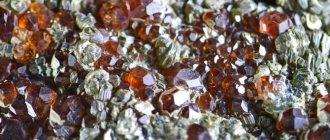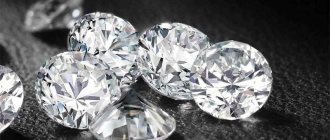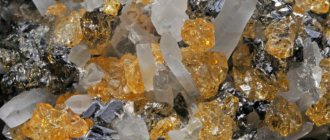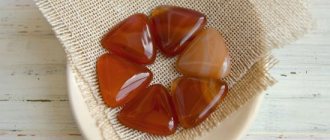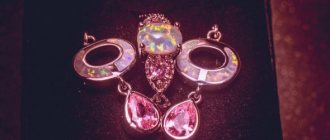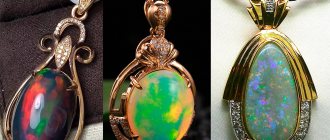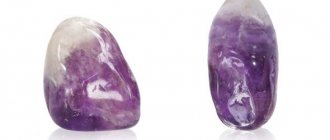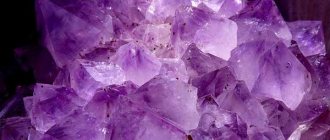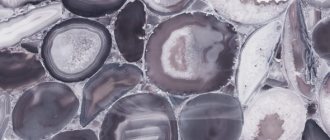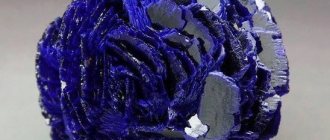History and origin
The story of a diamond is similar to the story of the birth of a moth. Like a beautiful butterfly, which was previously an inconspicuous caterpillar, a diamond was born after the competent transformation of the hardest mineral in the earth's interior - Diamond.
About six thousand years ago, on the Indian peninsula, people discovered an unusually hard mineral. For a long time, diamond was not considered a precious stone, and was not even one of the expensive minerals. They found him, but they didn’t know what to do with him. The strength of the nugget did not allow the stone to be processed using the technologies of the past.
It was only in the 15th century that the first diamond was produced in Belgium. The Flanders were able to develop diamond cutting technology, which turned the mineral into a world-favorite attribute of wealth, a symbol of the elite. Thanks to Louis de Bernel, the inconspicuous pebble began to shine with all the colors of the rainbow. To this day, diamond cutting technology is used to process other precious and semi-precious gems.
Do you know that one of the largest diamonds is on the crown of the Queen of England.
The first cut diamond went to the Grand Duke of Burgundy. Karl the Bold, together with his favorite Agnes Sorel, started the fashion for diamonds in high society. Since then, no ruler could resist the charm of the diamond, including the Russian Empress Catherine, as well as the Emperor of France, Napoleon Bonaparte.
There is much controversy about the origin of diamonds. The most famous version speaks of the formation of a mineral in the depths of the earth's mantle under diabolical pressure. Volcanic underground explosions bring the gem to the surface through kimberlite pipes. Diamonds are not rare stones. However, in order to obtain 1 carat of diamond, it is necessary to process 500 tons of ore . Such efforts, multiplied by the work of the craftsmen and all the rare qualities of the stone, determine the fabulous price of the gem.
Medicinal properties
Even though modern people are accustomed to receiving diamonds as a sign of attention, in ancient times they attached great importance to the stone, since they observed its healing effect on the human body.
- Diamonds help normalize sleep;
- Calm the nervous system;
- Helps improve dermatological ailments;
It was believed that the jewel strengthens the immune system and improves the functioning of human organs and systems. Diamonds helped ancient women who had lost hope of having a child to conceive, bear and easily give birth to offspring. In addition, the gem slows down the aging process.
Physical properties
Diamonds that become diamonds after processing, in addition to the highest hardness, have strong dispersion and light refraction. This feature gives the diamond a strong shine and iridescent tints.
Chemically, diamond is pure carbon. Under conditions of elevated temperatures, vacuum, or an environment filled with inert gases, the mineral becomes graphite.
| Property | Description |
| Formula | WITH |
| Impurity | N |
| Hardness | 10 |
| Molecular mass | 12,01 |
| Density | 3.47—3.55 g/cm³ |
| Refractive index | 2,417—2,419 |
| Fragility | Lasting. |
| Cleavage | Perfect on {111}. |
| Kink | Conchoidal to the point of splintering. |
| singonia | Cubic. |
| Optical axis dispersion | Strong. |
| Twinning | Twin germination according to the spinel law is common. |
| Shine | Diamond. |
| Transparency | Transparent. |
| Color | Colorless, yellow, brown, blue, light blue, green, red, pink, black. |
Artificial diamonds
The exorbitant price of processed diamonds is due to their beauty, rarity and strict rules of the game in the global diamond market.
Technology has created affordable options. Crystals are grown under conditions that replicate natural ones: high temperature and pressure or chemical vapor deposition. The formation features create a structure similar to natural stone.
The most beautiful and high-quality examples of artificial cultivation are cubic zirconia and moissanite.
cubic zirconia
The laboratory analogue is used in jewelry, science and industry.
Varieties and colors
Diamonds are divided into 3 color groups:
- White.
- Black.
- Fantasy.
White or colorless nuggets are considered the most popular and expensive gems. The highest quality stone is called a “pure water” diamond, since the ideal gem truly merges with water and is invisible in it.
Black stones were not considered precious for a long time, until one designer started the fashion for this gem by releasing the first collection of jewelry with black diamonds. This variety differs from other brethren in its opacity and absolute absorption of light. However, like other diamonds, black is endowed with a diamond-like luster.
Fantasy stones are replete with a variety of shades:
- Red. Rare and one of the most expensive stones. The price of 1 carat exceeds 300 thousand rubles.
- Green. The rarest, natural specimens are rare and are found in museums or private collectors. The cost of a carat of green stone is about 250 thousand US dollars.
- Blue. One of the rare varieties. The main color is complemented by shades of purple, green or gray. In many jewelry stores, a blue diamond is an artificial, radioactively irradiated stone.
- Pink. The variety of this stone is divided into another 20 distinct shades of pink. A rare nugget, found only once out of 100 thousand ordinary diamonds. It falls under the category of fancy gems only if there is no brown tint.
- Blue. A very rare gem of high value.
- Brown. The most inexpensive variety of all fancy stones.
- Yellow. A gem of a low price category, somewhat more expensive than brown.
Most often, fancy diamonds are called by a double name, for example, green-blue. The first component of the name is the main color, and the second is an additional shade. When describing fantasy stones, the degree of color saturation is also taken into account.
Yellow diamond magical properties of the stone
Yellow diamonds and cut diamonds look truly amazing. It’s not for nothing that they are called “drops of the sun”, since they carry the sun’s rays and the energy of light. The mineral has this color due to a small amount of nitrogen in the diamond. There are several famous and almost priceless yellow diamonds weighing over 100 carats. Such jewelry is usually not sold, but is housed in various museums around the world.
Alternative medicine and ancient world beliefs attribute the following properties to the yellow mineral:
- Treatment of joint pain, relief from bronchitis;
- Eliminates nicotine and alcohol addiction;
- Helps accelerate metabolism in the body and, as a result, normalizes excess weight;
- Relieves fatigue, relieves signs of depression;
- Wearing a stone on the left hand attracts love;
It should be borne in mind that it is advisable to receive such stones as a gift from a loved one, and not to buy them yourself. In this case, the energetic forces of the mineral are strengthened by the good thoughts of the giver. Under no circumstances should you keep a rough diamond obtained through unclean means. He will bring misfortune and anxiety into the house.
Criteria for jewelry evaluation of diamonds
There is an opinion that the main advantage of a diamond when evaluating it is its weight. But that's not true. Experts in their field evaluate diamonds according to the global 4C system - Cut, Clarity, Carat, Color, that is, “Cut, Clarity, Weight, Color.”
Cut
Cutting is the main asset of jewelry technology. Thanks to this type of stone processing, a once unattractive diamond was turned into a luxurious diamond. Correct cutting is aimed at the most positive result - preserving a greater percentage of the stone’s weight, eliminating flaws, emphasizing its advantages.
Cut elements
The classic diamond cut involves applying 57 facets and giving the stone a round shape. This method applies to all specimens 0.3 carats and above. 17 facets are applied to stones of minimum weight, and 74, 86 or 102 are applied to large samples. The round cut is also classified into groups A and B. The first indicates the ideal relationship between the shape of the stone and the facets, the second - imperfect proportions, elongation of the stone with a violation of symmetry.
Purity
The concept of diamond clarity includes the number and size of inclusions, as well as the degree of reflection of sunlight from the surface of the stone. The international classification includes 11 groups that determine the purity of a diamond.
Stone purity table
The Russian scale is somewhat different. For stones weighing up to 0.3 carats there is a 9-point scale, and for diamonds ≥ 0.3 carats there is a 12-point scale. At the same time, the best “pure water” gems are scored 1 point, and low-grade stones with a large number of inclusions are given 12 points.
Weight
In the category of measuring the weight of diamonds, the world and Russian systems are similar to each other - 1 carat is equal to 0.2 grams. There are three weight categories of diamonds:
- Large - over 1 carat.
- Medium - from 0.29 to 0.99 carats.
- Small – up to 0.29 carats.
Table of sizes and weight in carats
The weight of a stone in a product is determined by the Tavernier formula and applies to stones weighing up to 5 carats. According to this formula, the cost of a carat is multiplied by twice the weight of the gem. A specimen weighing 10 carats is 100 times more expensive than a one-carat stone. Experts advise paying attention to stones of 0.99 carats. Their advantage is that it is impossible to distinguish such a gem from a one-carat gem by eye. But the difference in price will noticeably please you.
Color
According to the Russian system, the color of a diamond is determined on a scale from 1 to 9. The first group includes perfectly transparent stones. Next, the degree of yellowish or brownish color is classified in ascending order. The last, 9th group, includes gems with visually pronounced shades of a different color. From the 3rd to the 5th group are the best-selling diamonds. However, the trick is that visually levels 3-4 and 4-5 cannot be distinguished, while the price is significantly different.
Diamond Color Chart
The international system evaluates the color gradation of diamonds and the degree of transparency on a scale from D to Z. Group D includes ideal stones without coloration. Group H includes yellowish diamonds, the color of which is visible to the naked eye. Category Z is the last, indicating the pronounced yellowness of the specimens.
Fluorescence
This indicator determines the degree of luminosity of a diamond in ultraviolet rays. Too high a level of fluorescence reduces the cost of the stone by 3 times.
Pink diamond magical properties of the stone
The pink color of a diamond is due to special chemical compounds within the stone. As a result, when light hits the mineral, predominantly pink shades are reflected. However, no one has yet been able to discover the substance that gives diamonds their pink color. It is believed that they acquired their color as a result of volcanic activity, because they are found mainly in areas where volcanoes erupted at different times. Such stones are of real value even in their raw form.
There are about 20 types of pink gems, depending on the color spectrum (from deep red to pale pink). Moreover, they all have important properties used to improve health and achieve the necessary results:
- Pink transparent diamond has a calming effect;
- Daily wearing of jewelry with such gems provides a feeling of endless happiness and euphoria;
- From the first days of wearing it, the new owner feels mutual love for a loved one;
- Such stones protect the house from unclean forces and evil thoughts of uninvited guests;
- In ancient times, people believed that such minerals could cure epilepsy and mental disorders.
How to spot a fake
Buying a diamond is an exciting event. The most expensive gem is easily imitated by synthetic cubic zirconia or cheaper minerals. To ensure that the investment is not erroneous, there are a number of ways to distinguish the proposed fake:
- Magnifier. Under a tenfold magnifying glass, inclusions that occur inside the diamond will be visible. It is worth remembering that there are no bubbles in a natural nugget.
- Clearance. If you put a real diamond on paper with text, you will not see the text and paper through it. And through a fake it is even possible to read what is written underneath it.
- Steam. Breathe on the pebble for a few seconds. A real diamond will not “feel” breathing. The fake will fog up or give itself away as droplets of condensation.
- Thermal conductivity. Natural stone remains cool even in hot weather.
- Heaviness. A natural mineral will sink in a glass of water, but an imitation mineral will not.
- Frame. Diamonds are not encased in cheap metals (silver, low-grade gold).
- Brand. A sample with the designation CZ will produce cubic zirconia. The reverse side of the product also indicates the carat value of gold or the PT symbol if the setting is platinum.
- Cut. The craftsmen who create diamonds do their job at the highest level. Therefore, diamond cutting involves focusing - the entire beam of light falling on the stone is collected at a single point. The fake does not have this effect.
- Oil. If you make an oil streak on a diamond, it will remain flawless, whereas on cubic zirconia it will spread and accumulate in droplets. And a natural diamond oiled will stick to the glass.
- Hydrochloric acid. A real diamond is not afraid of such a ruthless method. Phiantite will give itself away as the remaining acid stain.
Diamonds are also replaced with leucosapphires (colorless sapphires) or spinel. Water or glycerin will help distinguish such a fake - only the diamond will sparkle in these liquids. Jewelers evaluate the authenticity of diamonds using special instruments.
Remember, there is no DIY involved when purchasing diamonds. Take a knowledgeable person with you to the transaction so as not to get into trouble. Don't forget about the quality certificate for the stone. Ideally, this document is issued by the American Institute of Gemology. Such papers are also issued by the relevant authorities, for example the Moscow Gemological Center. Jewelry stores do not have the right to create such certificates.
Jewelry with mineral
A diamond is rightfully considered the most expensive gemstone. Only exceptional examples of other top five minerals - sapphire, alexandrite or emerald - can exceed its value. One carat of diamond with the best performance according to the 4C criteria starts at 25 thousand dollars.
Domestic stores offer an assortment of diamond jewelry at the following prices:
- Ring. For a product made of 750-carat white gold and for 3 stones with a total weight of 0.33 carats, you will have to pay 62 thousand rubles. If the total weight of diamonds in the same product reaches 0.77 carats, such a ring will cost about 200 thousand rubles.
- Earrings. Simple studs made of 14-carat white gold with diamond inserts weighing a total of 0.5 carats start at 65-70 thousand rubles. Inserts of 0.4 carats each will cost 200 thousand and more.
- Suspension. Fans of minimalism and cheapness may like the pendant for 20 thousand rubles. A diamond in such jewelry will weigh no more than 0.04 carats. An insert of 0.5 carats turns the cost of the pendant to at least 130 thousand.
- Brooch. Such jewelry with a scattering of diamonds with a total weight of 1.92 to 2.6 carats will cost from 460 to 600 thousand rubles on average.
Diamonds are also a profitable investment. If you want to make a profitable investment, buying a diamond is what you need. The price for a round-cut stone weighing 1.01 carats, the first in purity (1st category of the scale) with a very light color (3rd point of the color scale) can be 1 million 165 thousand rubles.
What did they say about diamonds in different eras?
For the ancient Romans, diamonds were fragments of fallen stars, for the ancient Greeks they were the tears of the gods, and in ancient India , the stone was considered perfect because it was formed from the five principles of nature (water, earth, air, energy and sky). The first diamond placers were found in India BC. In the ancient Indian treatise “Arthashastra” (IV century BC) there are references to duties on diamonds, indicating the special position of the stone.
The Roman writer Pliny the Elder, in his work “Natural History” (77 AD), speaks of the greatest price of a diamond, both among precious stones and among all human objects and things.
A diamond after jewelry processing is called a brilliant, which means “sparkling.” This word is of Latin origin and in its current form comes from Italian and French.
How to wear it correctly
In the case of diamonds, there is a special etiquette that must be observed if you do not want to look expensive but tasteless. It is better to select and wear diamond jewelry based on a number of rules:
- For young girls - small stones, elegant frames. For adult women – large solo stones and massive designs.
- Diamond is the stone of the night. Its radiance is greatest in the evening. Jewelry intended for daylight hours should be neat, inlaid with small gems.
- It is acceptable to wear diamond jewelry in the office. Moreover, there should be one decoration to choose from - neat stud earrings, an unobtrusive ring or a miniature pendant. The main thing is grace and minimalism.
- The clothing style for diamonds is classic business or evening. The wardrobe should consist of expensive branded items that match the jewelry. Combination with colorful, motley clothes is unacceptable.
- Earrings look better with short hair or hair pulled up so as not to obscure the beauty of the item.
- There should be one diamond ring. When rings are displayed on several fingers at once, this is bad manners. Only a combination of engagement and wedding rings is permissible if both have diamonds.
- There should not be a lot of diamond jewelry at the same time. The earrings can be combined with a pendant, necklace or ring and brooch at the same time. The ring can also be worn with a bracelet. Massive brooches or necklaces should stand out. You cannot combine a pendant with a brooch.
Yellow or rose gold frames complement blondes better. Brunettes can match contrasting jewelry made of platinum or white gold.
Men choose discreet classic accessories - titanium or platinum watches, cufflinks, rings, tie pins. Many people are impressed by inserts of black diamonds, which emphasize masculinity and complement the business style.
Recommendations for product care
The royal gem requires decent care. Despite its high hardness, diamond is a fragile and capricious stone. You can clean your jewelry at home:
- Use a light soap solution (except laundry soap), wiping with a soft cloth.
- Soaking in alcohol liquid. Medical alcohol, vodka or ammonia are suitable. Afterwards, the plaque is removed with a cotton pad.
- Gold frames can be cleaned with denatured alcohol.
Cleaning is carried out with gloves to avoid greasy marks from contact with skin. Special compounds for metals can damage the stone. Diamond is also afraid of soda, hydrogen peroxide, iodine, manganese, and vinegar. The best option is to take the item to a jeweler for cleaning. Diamonds are too expensive gems to be ruined by clumsy care.
Diamond jewelry is not worn at home, in the tanning salon, at the gym or on the beach. It is recommended to store jewelry in natural stone boxes and special soft bags. Overheating or falling may cause the diamond to crack.
Compatibility with other stones
Diamond is a fiery mineral. The proximity of Earth minerals (opaque stones), as well as Air stones, the connection with which leads to mutual destruction, is contraindicated for him. Energetically, diamond is incompatible with topaz.
The most expensive stone will not always endure the proximity of stones that are similar in element and equal in rank. Sapphires, emeralds, rubies and alexandrites are considered acceptable and beautiful combinations in jewelry. These gems usually act as the main insert, complemented by diamond scattering. The combination with pearls is considered an aristocratic classic.
The magic of mineral
Diamond is a stone of leaders and confident individuals. This is a powerful amulet and a strong protector. The diamond will give the owner determination, fortitude, protect him from bad influences, reveal strengths and increase self-esteem. A diamond will give a person optimism and attract good luck.
Important! An evil stone will turn evil even against its owner. The diamond must be given as a gift, otherwise a person will feel its properties only 7 years after purchase or not at all. A woman should be given a diamond by a man. For married women, a diamond is the guardian of the hearth, and for single women, it is a shield that will not allow them to enter into marriage.
Fantasy stones are also endowed with special powers. Blue, for example, improves the functioning of the body, and on a magical level acts as a symbol of devotion. Yellow stone is a companion of believers. Red serves as a spiritual “cleanser”, and pink embodies tenderness and femininity.
You can read about the magic of Diamond-Diamond here.
Compatibility by zodiac signs, names
Diamond is a universal stone. Each of the zodiac signs will discover the benefits of this talisman. The stone suits signs best.
(“+++” – the stone fits perfectly, “+” – can be worn, “-” – is strictly contraindicated):
| Zodiac sign | Compatibility |
| Aries | +++ |
| Taurus | + |
| Twins | + |
| Cancer | + |
| a lion | +++ |
| Virgo | + |
| Scales | +++ |
| Scorpion | + |
| Sagittarius | +++ |
| Capricorn | + |
| Aquarius | + |
| Fish | — |
- Aries. Perfect compatibility. Courage, determination and luck in the life of an Aries are guaranteed.
- Sagittarius. Diamond is a symbol of success in life.
- A lion. The mineral will make Lviv calmer, harmonizing the inner world.
- Scales. The amulet will give them determination and the ability to take responsibility.
Only Pisces are strictly forbidden to wear a gem.
Regarding names, the diamond is the patron of men with the names Ivan, Ilya, Lev, Vsevolod, as well as women with the beautiful name Inna.
General characteristics of the diamond
Some experts say that this stone represents the perfect balance of all four elements. Others believe that the nature of Fire dominates in it, because this mineral acquires extraordinary hardness during extremely hot processes in the earth’s crust. One way or another, everything about the diamond suggests that it is a stone of pure harmony, perfection and endurance. In Buddhist texts, the enlightened mind is compared to a diamond, a symbol of purity and limitless power. This mineral was also used as a talisman by famous Roman generals, believing that the diamond would make them invulnerable in battle.
Lithotherapists recommend wearing a diamond to develop determination and find your highest purpose. This mineral strengthens the will of its owner and inspires him to achieve his goals. But it is important to remember that a diamond is a stone of true spirituality, so these goals should not be self-centered and selfish. The Diamond will provide its assistance only to those people who want to work not only for themselves, but also for the benefit of all humanity.
Some experts argue that diamond is only suitable for people who have reached middle age, the prime of life. Of course, this stone can also be worn by younger people, but it is important to remember that it requires responsibility and inner maturity from its owner. Then he is able to help make your most cherished desires come true. This stone is one of those that suits all zodiac signs without exception.
A diamond has a powerful influence on the mind of its owner. This is a stone of deep self-knowledge, the discovery of your true motives and goals. A person wearing a diamond must be willing to face the darkest parts of his soul and successfully overcome them. Diamond also enhances talents given from birth. This mineral, like a prism, magnifies and clearly demonstrates everything that has been embedded in us since childhood.
Note
The luxury and brilliance of a diamond attracts aristocrats, young girls and mature ladies. The best friend of the diva Marilyn Monroe won the hearts of the entire female half of the globe. Solid but fragile. Strong but graceful. Talisman of good luck and determination. Eternal, indestructible, great.
Photo gallery of stone
Earrings with Amethyst and Diamond
5 / 5 ( 3 votes)

